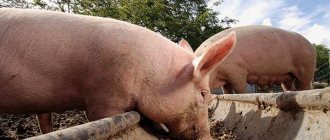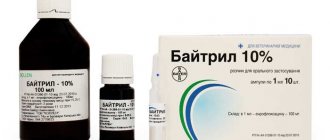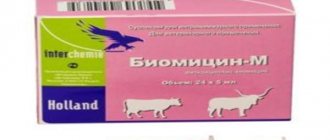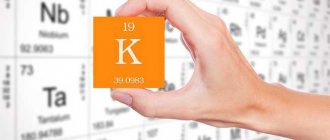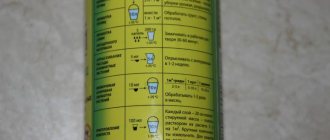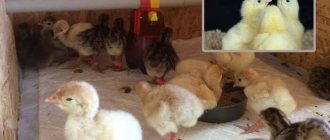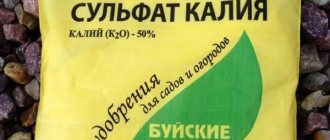Poultry farming » Chickens
0
3330
Article rating
Kira Stoletova
ASD for broilers is a real godsend in poultry farming, which helps to significantly reduce the risk of diseases of bacterial and viral etiology.
ASD for chickens and broilers
Composition and dosage form of the drug ASD fraction 2
ASD fraction 2 is a generally recognized veterinary drug that is widely used for the treatment and prevention of various infectious diseases in farm animals.
The medicine is made from animal waste (meat and bones ground into flour). The final product is obtained by dry distillation of raw materials.
The resulting aqueous solution of active adaptogens is of greatest value. They provoke the cell to produce substances necessary to protect against negative factors. The final fraction contains the following components:
- choline;
- ammonia salts;
- salts of carboxylic acids;
- peptides;
- esters of carboxylic acids;
- primary and secondary amines.
The substance is released in sealed glass bottles of various packaging (up to 5 liters). The yellow liquid is easily recognized by its characteristic pungent odor. It is used both externally and orally.
Small volume bottles are sold in cardboard boxes. Containers larger than one liter are supplied to the consumer without any additional protection.
Historical reference
The abbreviation ASD 2 for chickens means Dorogov's antiseptic stimulant, fraction 2. In the 50-60s of the twentieth century, this veterinarian and researcher made the first attempts to create a drug that would stimulate the strengthening of the immune system and increase resistance to external irritants.
Initially, the extraordinary scientist used frogs and sea creatures on which he conducted his experiments, trying to create the optimal formula. He came up with three options for condensation:
- Water without clinical significance.
- ASD instruction No. 2 for chickens, which indicates that the medicine is suitable only for birds and large animals.
- Preparation for external use.
After analyzing the components and their properties, Dorogov began to take bone meal to obtain the drug ASD-2. With this, the scientist proved that the extraction from any substance of animal origin is the same.
The use of ASD for poultry has a huge effect, because The drug has a complex structure that simultaneously affects several functional systems of broilers. The faction contains the following elements:
- choline;
- amines (primary and secondary);
- salt (ammonia);
- sulfhydryl substances;
- esters of C acids;
- ammonium salts of C acids.
The drug ASD for chickens is sold in glass bottles of various sizes: 50, 100 and 500 ml. The fraction is used both on large farms and individually.
ASD-2 is a liquid whose shade can vary from yellow to deep scarlet. At the bottom of the bottle, a fine-textured black or brown sediment usually remains. This does not affect the quality of the medicine in any way.
Pharmacological properties of the product
ASD-2 exhibits antibacterial and immunomodulatory effects in the body. Oral use of the substance will cause the bird:
- improving the functioning of the nervous system;
- stimulation of gastrointestinal motility;
- increased secretion of digestive glands and main food enzymes;
- accelerating the production of enzymes of ion and transport exchange between the body and the external environment.
See also
Description of the best treatment methods and for what reasons chickens fall on their feetRead
As a result, the animal experiences an increase in the cellular activity of internal organs and their systems.
The consequence of this is an acceleration of metabolism, increased endurance and tolerance to negative influences.
External use has the following effects:
- healing of the damaged area;
- relieving inflammation;
- normalization of cell function;
- tissue restoration;
- strengthening the immune system and the ability of tissues to regenerate.
A qualitative advantage of ASD-2 is the absence of a cumulative effect, that is, the animal does not become addicted. This allows you to maintain the effectiveness of the drug throughout the entire period of use.
Consequences of overdose
ASD is a highly effective drug that helps cure a wide variety of pathological conditions and diseases in chickens, pigeons and other poultry. The antiseptic stimulant is also widely used in industrial poultry farming. It is often prescribed for the treatment of ailments of laying hens and meat birds.
Thanks to its natural and absolutely harmless composition, ASD of the second fraction is able to relieve poultry from a variety of ailments. The medicine can be given to both adult chickens and pigeons, and chickens. Let’s talk about how to use ASD-2F and in what doses in poultry farming.
Indications for use
ASD for chickens is prescribed to:
- increase metabolism, which affects the weight of the bird;
- develop strong immunity;
- prevent the occurrence of diseases of the gastrointestinal tract (infections, poisoning, organ failures);
- carry out prevention against parasites;
- increase the egg production of laying hens.
In addition, the drug is applicable in the complex therapy of viral and bacterial infections. In chickens it stimulates active growth.
Oral course
The product gets inside the bird in two ways: either through drinking or through feed. The simplest option is to add two milliliters of the drug to a liter of water for feeding the bird. Here you need to take into account that one chicken consumes about half a liter of liquid per day.
Outdoor course
As a topical application, the product is used to heal damaged tissue. A weak solution of the drug is applied to the damaged area. Tissue regeneration accelerates, and the bird quickly recovers.
Dosage for broiler chickens and hens
The dosage of the ASD drug for hens and chickens depends on its purpose.
For chickens
In order to increase immunity in young animals and develop the body of pets, they are given ASD-2 35 ml of solution diluted in 100 liters of water for a week.
As a preventive measure against intestinal diseases and disorders of the functioning of the stomach, 3 ml of the drug is used per 100 birds, given with water for a week.
When colds and infectious diseases are detected, chickens are given 10 ml per 1000 birds along with water for 5 days in a row.
Kuram
In order to increase egg production in laying hens, ASD-2 is used for at least 5-7 days, 35 ml, which must be diluted in 100 liters of drinking water.
The dosage for the prevention and treatment of respiratory diseases, as well as gastrointestinal disorders for chickens is similar to that used for chickens: 3 ml of ASD-2 per 100 chicken heads, given with feed or drinking water.
Sometimes the drug should be used during the period of change of plumage in chickens in order to support their weakened body. In such cases, ASD-2 is sufficient at the rate of 5 ml per cubic meter of air mass, which is taken in a concentration of 10% and distributed in the poultry house as an aerosol.
Restrictions
Eggs from chickens that have taken the ASD-2 medication are used for food and sold without any restrictions. Similarly, the meat of chickens on which this medicine was administered is freely consumed for consumer purposes during forced or planned slaughter.
When using ASD-2 for hens and chicks, no cases of overdose or adverse side effects from exposure to its active components have been recorded. Complications in poultry after treatment with an antiseptic stimulant are not observed.
Instructions for use
The effectiveness of the therapy directly depends on the correctly calculated dosage. For each case we apply our own course of treatment. To improve the health of the bird, it is necessary to learn how to work with the drug.
For chickens
In a limited dosage, the product helps chickens adapt to irritating environmental factors. The product also helps with apteriosis (lack of feathers). The optimal ratio is 3 milliliters of ASD per 10 liters of water. The course lasts two weeks, then the bird rests.
The product is administered orally to the chicken through drinking. With breaks, the course can be repeated 3-4 times until the desired result is achieved.
For broilers
Constant use of the drug accelerates growth and allows you to achieve weight gain after two weeks of drinking. This is especially important for broiler chickens. An adult chicken easily gains five kilograms of weight under the influence of ASD.
See also
Symptoms and treatment of avian influenza in chickens, signs and manifestationsRead
For laying hens
The action of the product increases resistance to negative environmental irritants.
This means that the chicken's egg production is less dependent on light, temperature and stress. The medicine also helps with salpingo-oophoritis of laying hens (inflammation of the oviductal tract).
Therapeutic effect of antiseptic stimulant
The medicine is unique and has no analogues. How to distinguish a real drug from a fake, read this article. The appropriate use of ASD in recommended dosages and in full course will help to increase the protective properties of the body, treat a wide variety of ailments, and also increase the egg production of laying hens.
Eggs and poultry meat taking the composition can be eaten and sold without any restrictions. When taking the antiseptic stimulant to chickens, pigeons and chickens, no cases of overdose or side effects were recorded. This indicates that ASD-2F brings exceptional benefits to the bird’s body.
Possible side effects
Side effects are only possible in humans. These include an allergic reaction, toxicosis or a slight burn (if a large amount of the substance comes into contact with the skin).
Chickens take the drug very well. It can be used at any age and in any condition of the bird. It will not cause any complications in animals.
Tips and tricks from experienced poultry farmers
The product turns out to be quite economical. On average, for a herd of 100 adult individuals, one bottle lasts for a month. Many farmers use the following scheme - for prevention, they give the product 2 times a month, in courses of 5 days, so that there is a gap of at least two weeks between them.
Important! This remedy is especially relevant in the spring, when laying hens are preparing to lay eggs.
The question remains of how to give ASD-2 to chickens. The instructions say that this can be done with water, but many birds do not come to the drinker often enough to get the drug in the required quantity. This is especially true for young animals, but adults, especially when walking, can ignore the drinking bowl (for example, in autumn or winter they eat snow).
To ensure that a chicken or an adult hen receives a sufficient amount of the medicine, it is mixed with feed, at the rate of approximately 15 cubes of the drug per 30 heads. This amount of medication is thoroughly mixed with a small portion of food and then added to the general feed. It is best to do this in the morning. However, the bird still needs to be watered. You need to leave plenty of clean water next to the feeder.
ASD-2 has an unpleasant odor. The farmer who will breed it is recommended to work in the fresh air. But this smell does not bother the birds at all.
The drug deteriorates quite quickly when exposed to air, so it is given immediately after dilution. Take the drug with a sterile disposable syringe, without even removing the rubber stopper from the bottle.
Using the drug in accordance with the manufacturer's instructions helps to raise healthy young animals in a short time. It is economical, safe and effective.
History of origin
The name of the medicine stands for Dorogov’s antiseptic stimulant, fraction two. In the middle of the last century, veterinarian, scientist and extraordinary researcher Alexey Dorogov set out to create a previously unknown drug. The medicine was supposed to strengthen the immunity of humans and animals, making it more resistant to diseases and external influences: radiation, injuries.
Description of the plum variety Eurasia, cultivation and care, pollinators
Dorogov decided that to create such a drug, it was necessary to focus on those living creatures that are extremely tenacious and unpretentious in themselves. Therefore, the first batches of the antiseptic stimulant were obtained from frogs. These amphibians tolerate both high and low temperatures and are practically not susceptible to various diseases.
An antiseptic stimulant was produced by burning and subsequent sublimation of frogs. Later, other sea creatures were added, including jellyfish. During combustion at high temperatures, vapors were generated. The scientist collected them, assuming that it was this liquid that stored all the valuable substances. He managed to obtain several options for condensate:
- the first is represented by water and has no clinical significance;
- the second – fraction 2 – for veterinary use;
- the third is for external use only.
Subsequently, having carefully studied the composition of the liquid and its properties, Dorogov came to the conclusion that the use of frogs was not economically profitable. For the production of ASD-2, meat and bone meal began to be used. The scientist proved that obtaining an extract from any animal raw material is equally effective.
Today, there are several factories that continue to produce ASD-2 using the technology of researcher Dorogov. It is this second faction that has become most widespread. The drug is actively used in veterinary practice, as it has a wide spectrum of action.
In the process of adjusting the manufacturing technology, the scientist managed to achieve high-quality purification of the drug. He believed that ASD was absolutely non-toxic and did not contain toxic substances. Among other things, Dorogov neutralized the ammonia that was obtained during the first experiments. In his studies, he administered the drug intravenously to experimental mice in doses that were many times higher than therapeutic doses and did not experience any side effects. What proves the safety of the medicine for animals.
Dosage
An antiseptic is a stimulant that can be given in combination with antibiotics. In order for it to act correctly, you need to know how to dilute it and what the dosage is by age category.
ASD for chickens
The drug increases the duration of the productive period and egg production rates in laying hens, improves resistance to negative environmental phenomena.
Fraction ASD No. 2 can be diluted with water or given with dry food. The dose is 3-3.5 ml of product per 10 l/kg.
For day old chicks
The use of ASD requires caution. In the first 24 hours of life, young birds are exposed to negative environmental influences: temperature fluctuations, sudden changes in environment, etc.
To increase survival, some farmers use antibiotics, the dosage of which is minimal. But their action has many side effects that are associated with the functioning of the gastrointestinal tract.
Therefore, with the first feeding, ASD fraction 2 is used for chickens. In this age period, they approach the use of Dorogov’s antiseptic stimulant with caution. The dosage is small: 35 ml of ASD is added per 100 liters of liquid or 100 kg of feed.
The drug is used continuously for 14 days. This will allow the young animals to develop strong immunity.
Another option is aerosol. 5 ml of a 10% solution is sprayed onto 1 m³ of poultry house. Repeat the procedure 1 r. in 10 days, until the chickens reach 1.5 months of age.
For young animals
Chickens of this period are characterized by rapid metabolic processes, individuals grow quickly and gain weight. ASD fraction 2 for chickens is given according to the instructions, because the calculation is based on the weight of the bird. For every kg there is 0.1 ml of the drug. Over time, the daily dose of medication increases. Stable use for 1.5-2 months leads to significant improvements and increases in bird productivity.
Respiratory diseases
Chickens are birds that suffer from various diseases. The most common of them:
- bronchitis;
- tracheitis;
- laryngitis;
- mycoplasmosis.
These pathologies are quickly transmitted by airborne droplets. For the treatment and prevention of diseases affecting the respiratory system, the following dosage of the stimulant is used: 1 ml of ASD per 100 chickens. For adults, the dosage is slightly increased: for 100 chickens - 3 ml of antiseptic. For infections, the medicine acts due to the body’s resistance and activation of the immune system. Over the course of 4-7 days, the product is added to the liquid or feed.
How to cook couscous at home: what kind of cereal it is, as well as the benefits and harms of porridge


